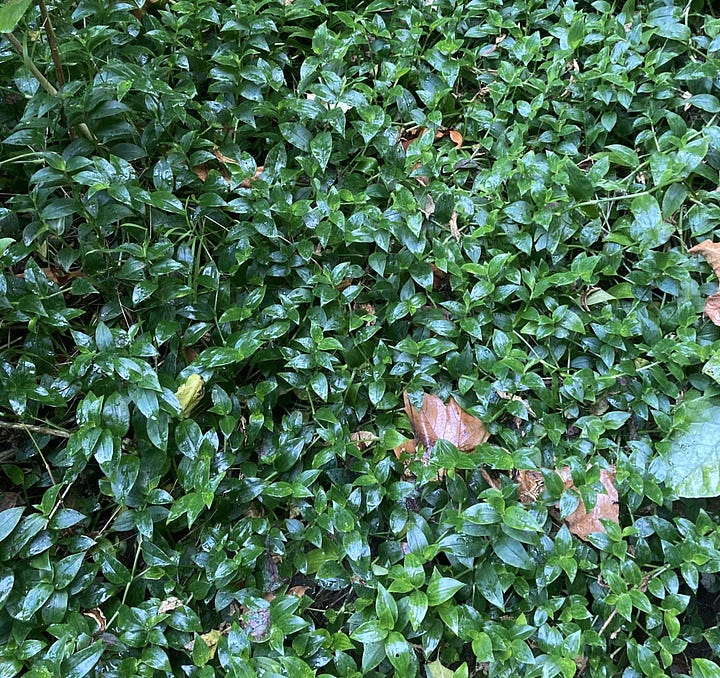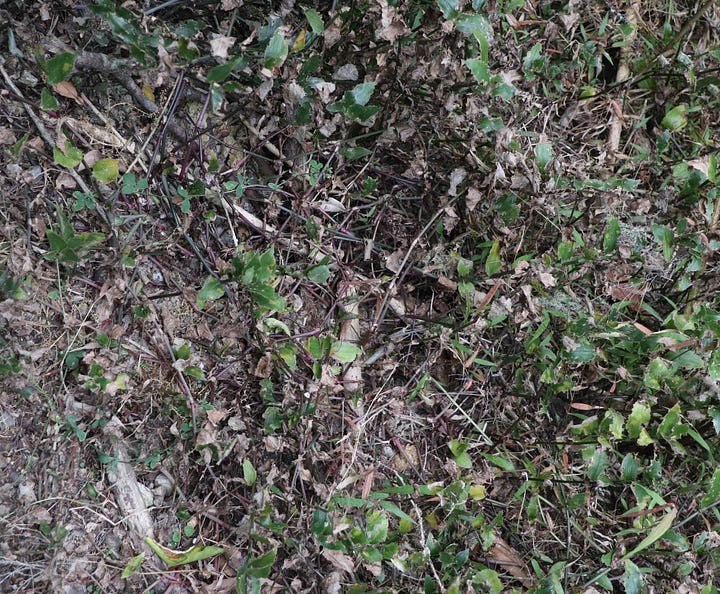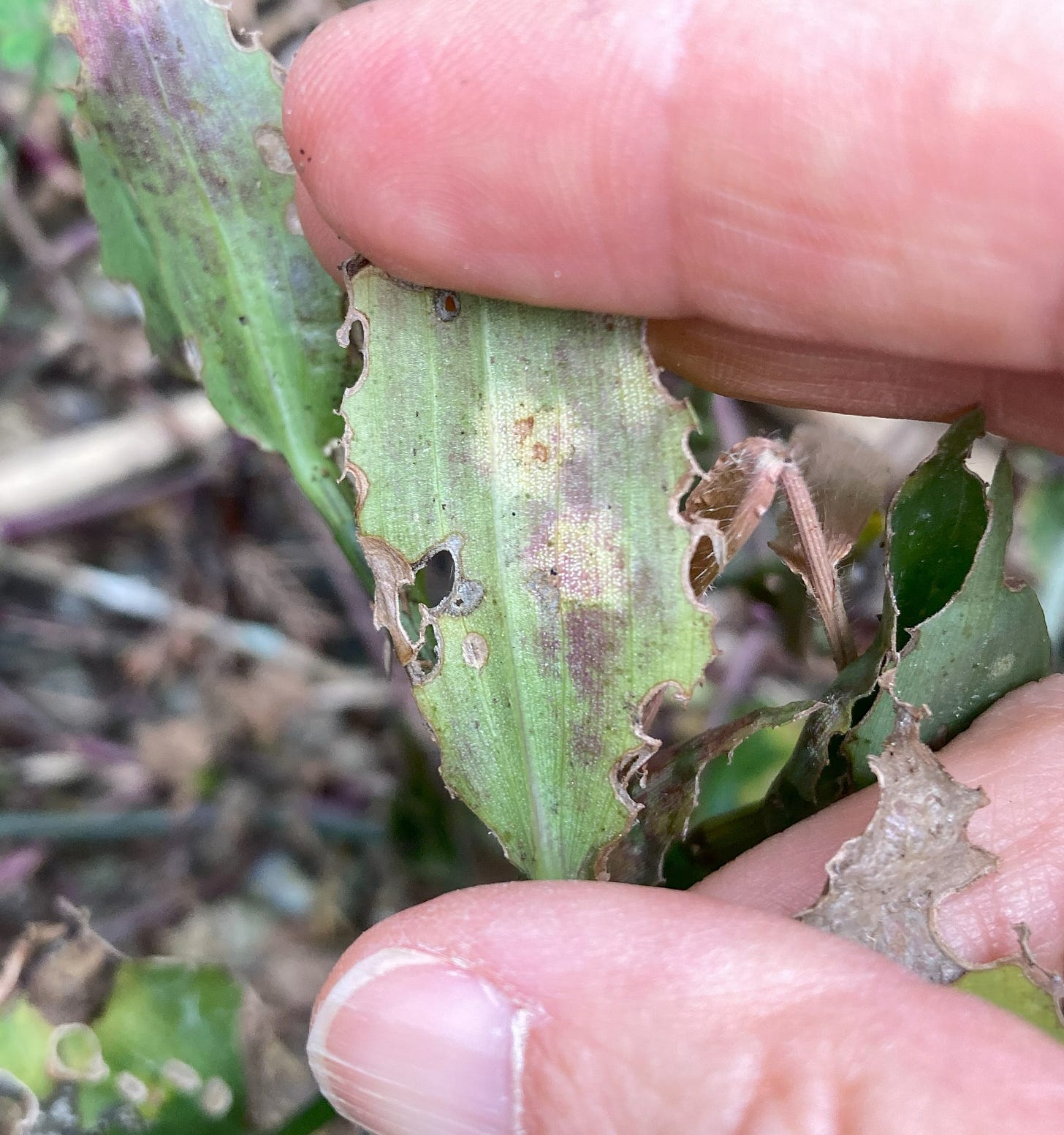My enemy's enemies
Sometimes, the answer to an invasive species problem is to introduce more new species (10 minute read)
Although I’ve been complaining about the wet summer weather, it does have a positive side. During the winter a group of volunteers planted a number of native trees, shrubs and sedges in an area where blackberry had been cleared in Cashmere Park. The growth on these plants has been spectacular. Some of them have more than doubled in height and width. Since there is a stream not far from where these seedlings are, I was prepared to carry some buckets of water if they started looking parched, but they’ve never had a chance to dry out. It has been inspiring to watch the progress.
Of course, the regular watering hasn’t only benefitted the native plants. Weeds have been sprouting as well. Some are nothing to worry about – there are wild radishes, a kind of nightshade and a few common garden weeds which grow well in disturbed areas but aren’t likely to smother native plants or persist once there’s a canopy. But the area we are working in has blackberry, convolvulus, climbing dock and tradescantia as well. In combination, these weeds would easily smother our young plants and prevent any native regeneration in the area.
If we can keep them under control, the blackberry, convolvulus and climbing dock will be mostly shaded out once our new plants form a canopy. In Cashmere Park, there are a number of areas where this has happened from plantings 15-20 years ago. But the tradescantia is another matter. I’ve written about this beast before – describing it as the mythical hydra which grows several new heads when one is cut off, because it regrows from any discarded fragment. It isn’t suppressed under a canopy, in fact it grows even better. It is only suppressed under the densest forest canopy, one which takes decades to develop, not a few years. Even then, it still survives.
This plant is the bane of everyone involved with restoring lowland forest fragments in New Zealand. In Wellington, every reserve is fringed with it, and in places it grows a couple of feet deep. Because it’s so ubiquitous, I notice it, but seldom pay it much attention. But when I was in Auckland last week, I saw some plants which stopped me in my tracks.
I was walking in a reserve in Birkenhead, one of the gullies with some stunning, ancient trees and a lot of weeds in the undergrowth. I have some treasured memories of these reserves, but they also sadden me, because they need a lot of help if they are going to survive. Like Wellington’s reserves, they are all edged with tradescantia. But I’d never seen tradescantia in Wellington looking like this.
I pulled out my glasses for a closer look. Every single leaf was ragged – something had clearly been eating it. Most of the leaves had blotches of yellow or brown as well. Most notable, though, was the fact that there were patches where the leaves were completely gone, and there were just stems sprawling over the ground. Amongst the stems, I saw the leaves of basket grass, a native grass which naturally forms part of the groundcover in our northern forests.


I’ve never been so excited at the sight of a sick plant.
The damage I saw in that Birkenhead reserve wasn’t an accident. It resulted from 25 years of careful research and risk assessment. The ragged condition of the leaves was caused by a Brazilian beetle first released in New Zealand in 2011. The yellow and brown blotches were caused by a fungus, also from Brazil, first released in 2018.

When this approach, known as biological control or biocontrol, is effective, it is amazing. It’s based on the idea that when a species is in its native range, it is kept in balance with other species by predators, pests and diseases – known as natural enemies. But when something is moved to a new area, those natural enemies can be left behind, allowing it to get out of control. Introducing those natural enemies might restore the balance. But not every attempt at biocontrol goes well. When it goes wrong, it can be disastrous.
What’s the difference between a successful biocontrol programme and a disaster? And can we know what potential biocontrol agents like the beetle or fungus will do before they are released?
At first glance, the history of biocontrol appears to be a litany of disasters. In the 1870s, ferrets, stoats and weasels were introduced to New Zealand to control rabbits. They contributed to the decline and even extinction of many native birds, while failing to control rabbits. In the 1930s, cane toads were introduced to Australia to control the sugar cane beetle and other sugar cane pests. They contributed to the decline of many native species, while failing to control the beetle. In 1955, the rosy wolf snail was introduced to Hawai’i to control the giant African snail. It was the major cause of the extinction of hundreds of native Hawai’ian snails while – you guessed it – failing to control the giant African snail. In the 1960s, a beetle was introduced to North America to control nodding thistle. In this case, it did reduce the numbers of nodding thistle plants, but it also had serious impacts on some already uncommon native wildflowers.
With such a disastrous history, why do we still persist with biocontrol. How can we be confident it won’t be a disaster next time?
To me, here is where the story gets interesting. It’s a story which offers important insights into the value of risk assessment, and also illustrates one of the most important reasons why risk assessments fail.
Ferrets, stoats, weasels, cane toads and rosy wolf snails have one important characteristic in common. They are all generalist predators, which means they aren’t fussy about what they eat. If a stoat comes across a bird it’s never encountered before, it won’t think twice before gobbling it up. Likewise, if a rosy wolf snail encounters a new kind of snail – well, gobble isn’t the right word because the whole process happens in slow motion, but it will certainly eat it up.
This means that it should have been obvious what would happen when these species were introduced to new areas. And it was. Even in the 19th century, people could see what would happen. The introduction of ferrets, stoats and weasels to New Zealand was widely opposed, even by Sir George Grey, the former governor of New Zealand. Grey was an ardent advocate for introducing all kinds of exotic species, but he drew the line at ferrets, stoats and weasels.
In risk assessment terms, the consequences were recognised. The problem was that those who wanted to introduce these species either didn’t listen to the evidence, or they simply didn’t care. Those who were concerned about rabbits, or sugar cane beetles or giant African snails were thinking of the possibility that these generalist predators might help solve their problem. This possibility overrode any concern for native birds, or their neighbour’s poultry or 750 species of snail found nowhere else in the world.
The case of the beetle introduced to control nodding thistle is a little different, and it warrants closer inspection. It’s not a generalist predator, but feeds on the seeds of thistles. Researchers made specific efforts to identify insects which attacked nodding thistles in their native range, and selected the beetle as one which was particularly damaging. However, botanists recognise thistles as a huge group of plants – there are around 2400 species. In its native range, the beetle was known to feed on many species in this group. So nobody should have been surprised when it attacked North American species belonging to this group. Again – the prediction was not the problem. At the time, those making the decision just didn’t think that North American thistles being eaten was worth worrying about.
The same beetle has been introduced to New Zealand as well, but we are luckier. We have no native thistles, and the beetle has behaved itself. It hasn’t had a major effect on nodding thistles here, but it hasn’t endangered any native species either.
The biological control of today is not the same as the biological control which unleashed such disasters as the stoat and the cane toad. Today, researchers look for species which are not generalists, but specialists. Some species are such fussy feeders they will starve before they try eating anything other than their preferred food. If you’ve ever had monarch caterpillars eat your swan plants down to a bare stem, you’ll know what I mean. There are a few things you can keep them alive on, but it’s a struggle. Myrtle rust is another example – it’s a problem on many plants within the myrtle family, but won’t touch anything else.
Many insects and diseases are even fussier – depending on only a single species. One of the reasons we were able to eradicate smallpox from the world is that it infects only humans. The same is true of the fungus which I saw infecting tradescantia in the forest in Birkenhead.
But how can we be sure?
This is where the science of taxonomy helps. Biologists like to classify living things based on their family trees. For example, New Zealand’s native pōhutukawa trees are classified as part of the myrtle family, along with mānuka, guava and gum trees, because they all share a common ancestor millions of years ago. Why do they use this approach? It’s not just arbitrary. In fact, it’s extremely powerful, because it isn’t only biologists who use this classification. Many insects and diseases recognise this classification as well. If you want to keep your monarch caterpillars alive, your best chance is to find plants which botanists recognise as being related to swan plant. If you want to know if a proposed biocontrol agent will stray from its intended target, you find the closest relatives and test them.
This is exactly what biocontrol researchers do. In the early 1970s, a scientist proposed an approach to testing biocontrol agents for weeds based on the weed’s family tree. An agent such as the fungus I saw infecting tradescantia has been tested against dozens of species, with the most intensive testing on the most closely related species. It’s a slow, expensive process requiring international cooperation but it works. It’s been successfully used hundreds of times.
Reviews on the safety of weed biocontrol have found that there is sometimes a small amount of damage on plants related to the target weed, but any serious impacts have been like the nodding thistle beetle – predictable, but disregarded at the time. Taxonomy – figuring out species and what they are related to – is sometimes seen as a rather arcane science with limited practical use. But it’s the foundation for understanding how the natural world works, and making reliable predictions about what will eat what.
When I heard that tradescantia was proposed as a target for biological control in New Zealand, I admit I was excited. Not only do I know the damage this plant does, but I also knew it was a perfect biocontrol candidate. In New Zealand, we have no native species which are closely related to tradescantia. Although there are a few house plants and one well-behaved garden plant which are related, there are no crop plants. It’s a much easier prospect to find something which will safely control tradescantia than it is to find a biological control agent for an invasive grass or pine tree. Much of our economy is built on grasses and pine trees, and we have many native grasses too, so the consequences of an error are much greater.
Risk assessment for biocontrol has important lessons for other kinds of risk assessment, such as gene technology. We should always be concerned about possible unpredicted impacts from a new technology. However, I’m starting to think that’s not the main issue. In an example I’ve already mentioned – modifying crop plants to resist the herbicide Roundup – the negative consequences were predictable and predicted. They just weren’t considered important enough by those making the decisions.
This is why risk assessment is not purely a matter of science and not just a matter for scientists and regulators. Science is good at making predictions about what is likely to happen, what may happen and what is implausible. It’s not perfect, but it’s getting better all the time. However, science can’t predict whether we will one day be upset about the extinction of hundreds of snail species, or some spiky wildflowers. It can’t tell us what matters. That’s up to all of us.
This article was prompted by work I’ve been doing developing a course about risk – aimed at giving the public the knowledge to get involved in these kinds of discussions about risk. If you want to know more, there are still places on the course. Find out more at the link below:




Fascinating, Melanie. Good to hear of examples where it has worked!
Japanese knotweed is an troublesome invasive plant in the UK. There has been an investigation into whether or not to introduce a Japanese insect and a fungus that attack knotweed and nothing else. I don't know how this went. Standard advice still seem to be killing it with glyphosate. https://assets.publishing.service.gov.uk/media/5a7cded040f0b6629523c4d6/scho0209bphy-e-e.pdf